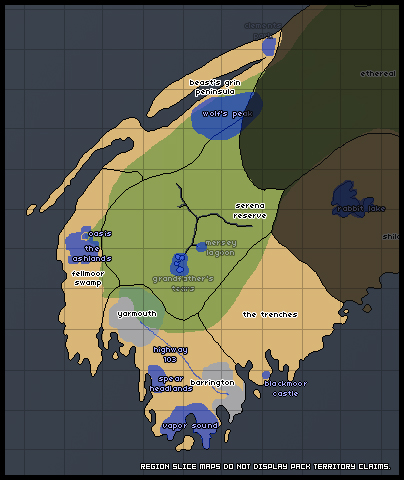04-01-2008, 01:31 AM
[html]<style>@import url('/ipb/html/territory.css');</style>
[/html]
Western Tangles
The Western Tangles are the westernmost ends of the Nova Scotian peninsula, consisting of coastline and some of inland forest. Much of the coast here is particularly cool and wet; as the Atlantic Ocean meets the Bay of Fundy, the area is subjected to some of the harsher tides and weather the cold waters can muster. Fog covers the coastline frequently, snaking far inland to serenely cling to the drier inland wilderness. Evidence of humanity can be found far to the south in the towns of Yarmouth and Barrington and on some of the islands dotting the coastline.
Statistics
- Climate: The southerly parts of Nova Scotia jut out into the ocean, surrounded by the bay and Atlantic. While the southern climate may not match the north for its cold winter, the south can boast the thickest and most persistent fog.
-
Geography: The Western Tangles region is dominated by low, large hills and the basin containing Serena Reserve's inland forests. There are numerous rivers and small streams throughout this territory. Perhaps most interesting is the southernmost shoreline, with its numerous harbors, bays, and islands.
-
Demographics: Many areas of this region show some evidence of human occupation, primarily small villages and sprawling farms.
-
Prey: Abundant -- the vast swaths of inland forests, untouched even before humanity's destruction, provide extensive land for all manner of prey animals.
- Fauna: Elk are the dominant species, though they do not frequent the coasts. Peregrine Falcon and the Osprey as well as various species of cranes, plovers, and sandpipers are among the shorebirds found in this region. Horses can be found on Cheval Island and, rarely, along the mainland coast close to the island.
-
Flora: The Northern Bayberry finds even the rocky and unforgiving soil of the coast suitable; Sweetfern and invasive Fennel prefer inland forest. Eastern Hemlock, Black Spruce, White Pine, and American Elm are the dominant tree species.
Recommended Information
- General Areas Information: Basic information about our setting and how to navigate the neutral territory forums.
- Current Weather: Check out what it's like right now in Nova Scotia, Canada!
- Flora and Fauna @ RP Guide: Find out what kinds of creatures your character is likely to encounter while exploring the territory.
More Information? Show it!


